The stalemate in the North Sea finally ended in May of 1916. The battle began with a clash between the two side's battlecruisers. David Beatty then lead the German High Seas Fleet into the arms of John Jellicoe's Grand Fleet. Jellicoe managed to pound the High Seas Fleet, but Scheer eventually broke contact. Unfortunately, Jellicoe was still between him and his base, and it was now night.
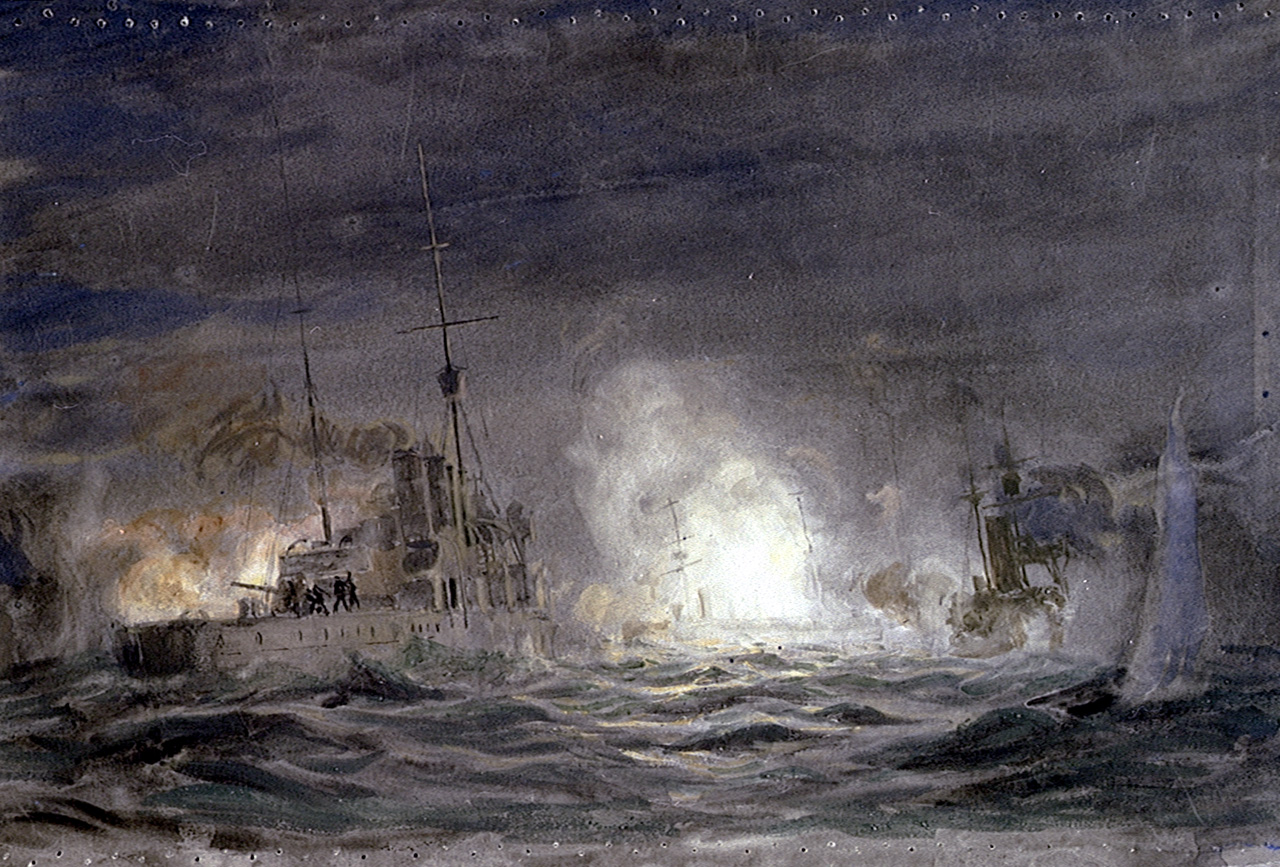
Jutland: The Night Action
After darkness fell, Jellicoe kept his fleet moving south, trying to cut off the direct path to Wilhelmshaven. To cover the possibility that the Germans would make for Horns Reef instead, he dispatched a minelayer to the area to join the submarines already on station. For the night, he placed his battleships in four columns alongside each other, and placed his destroyers behind his fleet to catch the Germans if they tried to cut behind him. The cruisers were spread out on the flanks and ahead. Beatty was steaming parallel to Jellicoe, ahead and to the west. He had cut ahead of the Germans, and was directly in front of them by 2230.
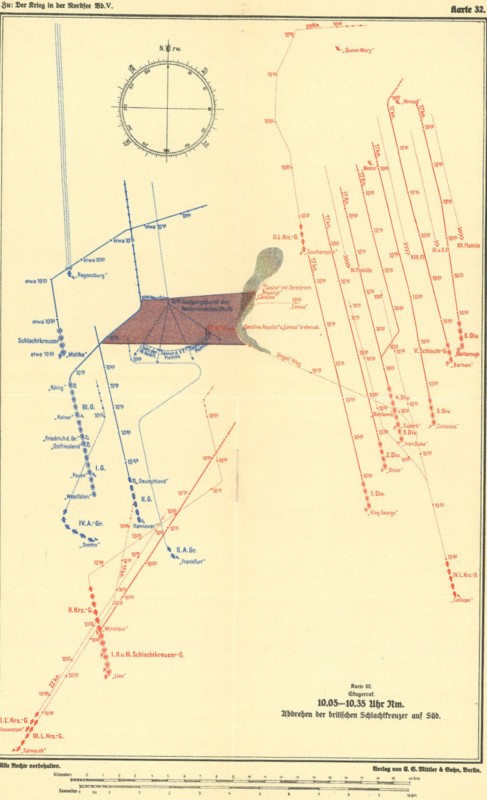
The night action is when the British performance really began to fall apart. Reporting up the chain of command was basically nonexistent, apparently because most officers assumed that Jellicoe already knew the situation. Of the few ships that did attempt to send radio signals, some were jammed by the Germans. Jellicoe’s orders were not entirely clear, which didn’t help. Many of his subordinates thought that they were not supposed to engage without orders, at least partially because of a fear of the Germans having superior night-fighting capability and equipment. Most notably, the British spotlights took time to warm up, and their filaments continued to glow after they were shut down, providing a target for the Germans, who did not suffer from either disadvantage. There were also the lingering effects of the stagnation the Royal Navy had undergone in the 19th century, as the reminders of the Napoleonic Wars faded. This is often overstated, but the night action at Jutland gives critics plenty of ammunition.
In fairness to the British, night actions are inherently risky things, and the chance of a German victory changing the balance of forces in the North Sea was too great. A particular risk is that ships on the same side would start to engage each other,1 and the British after the battle put much more emphasis on ship recognition. Likewise, the initiative that is so often considered necessary to military success is a double-edged sword. While it is important in single-ship or small-unit actions, it can become disastrous in cases where large numbers of powerful units are operating in close proximity.
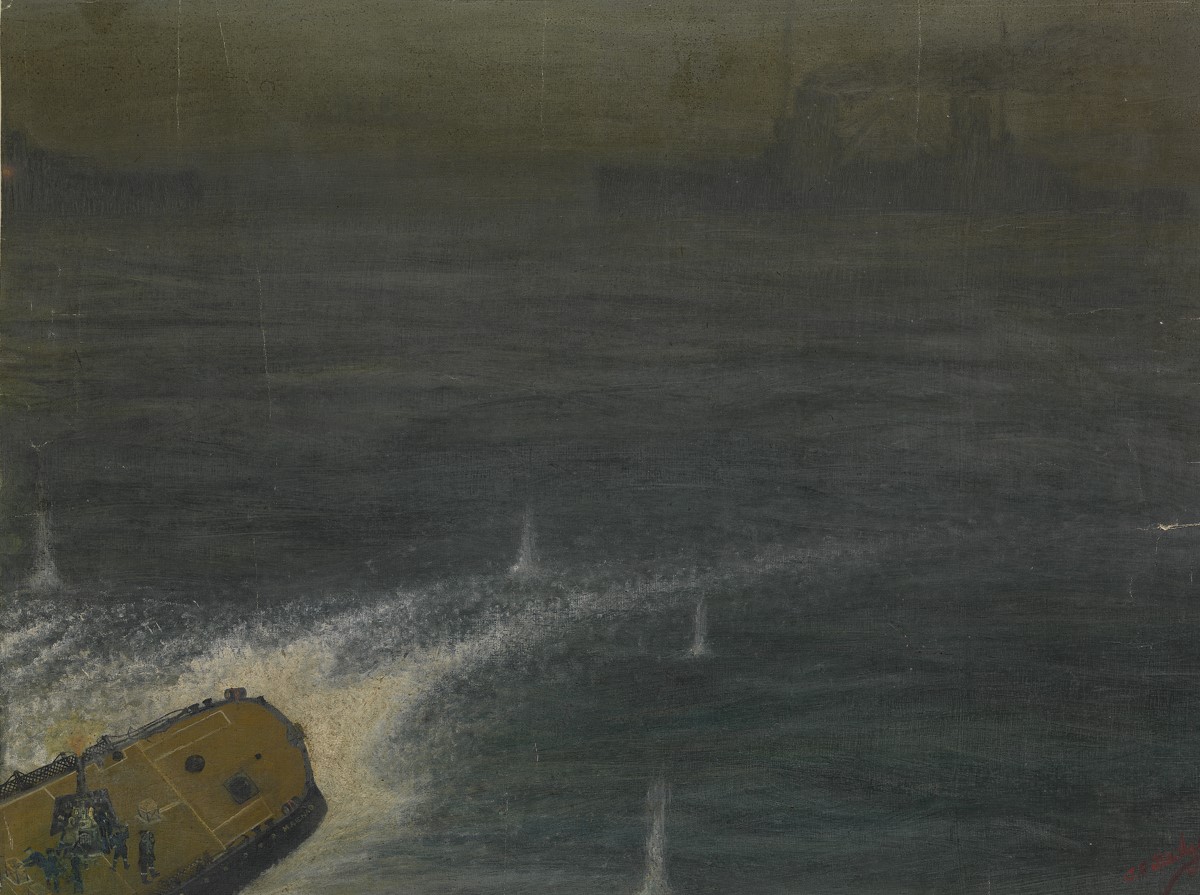
Things began to go wrong at 2200, when Lion, who had lost her codebooks, signaled Princess Royal for the night’s recognition codes. This signal, and part of the reply with the code, was seen by a German cruiser, and contributed to the later confusion. At 2245, Jellicoe transmitted a position signal to the fleet, then fell into a fitful sleep on the flag bridge of Iron Duke.
At the same time, Scheer was turning his fleet southeast for Horns Reef. He sent several signals, which Room 40 picked up. Some of them were transmitted on to Jellicoe, but not enough to overcome the distrust that the report placing Scheer in the Jade that morning had produced. There is speculation that not all of the information was sent, to prevent the Germans realizing the British had broken their codes, although this is impossible to confirm.

I’m not going to go into detail on all of the actions that occurred between the British destroyers and the German fleet. There were seven, spread between 2300 and 0430. The first was a skirmish between British and German destroyers, which blunted an attempted German destroyer attack with no losses on either side. A few minutes later, another group of British destroyers clashed with German cruisers, the British light cruiser Castor, leading the destroyers, suffering heavy damage. Unusually, this incident was reported to Jellicoe, who misinterpreted the cruisers as supporting a German destroyer attack on the Grand Fleet, instead of being part of the main body’s screen.
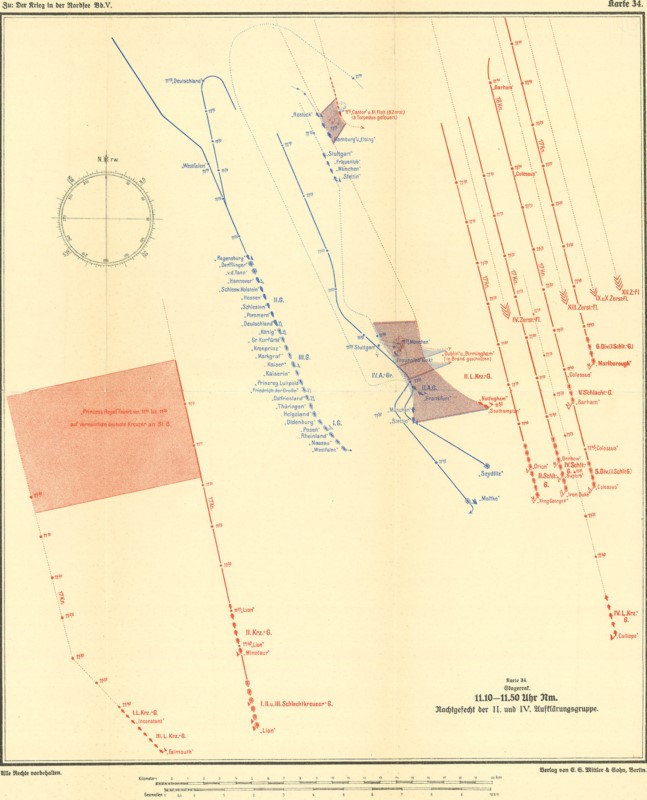
Goodenough’s 2nd LCS was also a participant, fighting a short action with a group of German cruisers at around 2320. This time, the German cruiser Frauenlob was torpedoed and sunk, but Southampton, lucky earlier in the day, was badly damaged by 18 hits. Goodenough’s radio was damaged, and his report did not reach Jellicoe for over an hour. Jellicoe and the battleships could hear and see these actions, but did not respond, for reasons that are not apparent a century later.
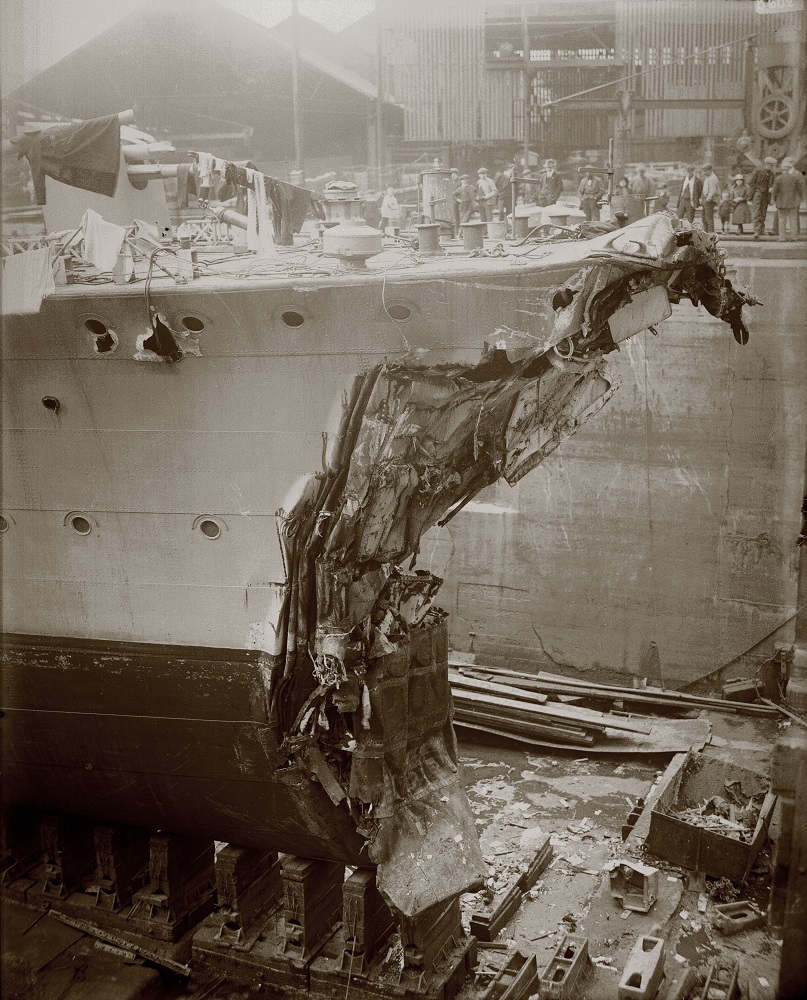
HMS Broke, one of the survivors of the 3-way collision
An hour later, the British finally encountered the German main body. Due to the problems of recognition at night, the destroyer leader Tipperary managed to close to within 700 yards of three German battleships, who pummeled her with 5.9” fire. Her destroyers scattered, fighting a wild, chaotic night action that saw three of them collide at high speed, and two of the crews involved attempt to abandon ship into the other vessel.2 The German cruiser Elbing was also rammed by the battleship Posen, and had to be abandoned after both engine rooms flooded.

HMS Spitfire after the battle
A third collision occurred when the destroyer Spitfire hit Nassau, the first German dreadnought. Spitfire’s bow was badly damaged, but the Germans discovered that Nassau’s guns could not depress enough to bear on her. However, their muzzle blast was sufficient to blow away her bridge, funnels, and boats. Eventually, Spitfire got free and returned home, bearing a 20-foot length of Nassau’s side plating. The British attempts to launch torpedo attacks were totally unsuccessful, and two more of their destroyers were sunk by gunfire during this phase of the action. The armored cruiser Black Prince, part of the same squadron as Defense and Warrior, blundered into the middle of the action, and was sunk with all hands around midnight by the fire of five German battleships. This was made even more tragic by the fact that at least one British battleship, Thunderer, saw the action, and could have intervened if her captain had not been afraid of betraying the fleet's location.
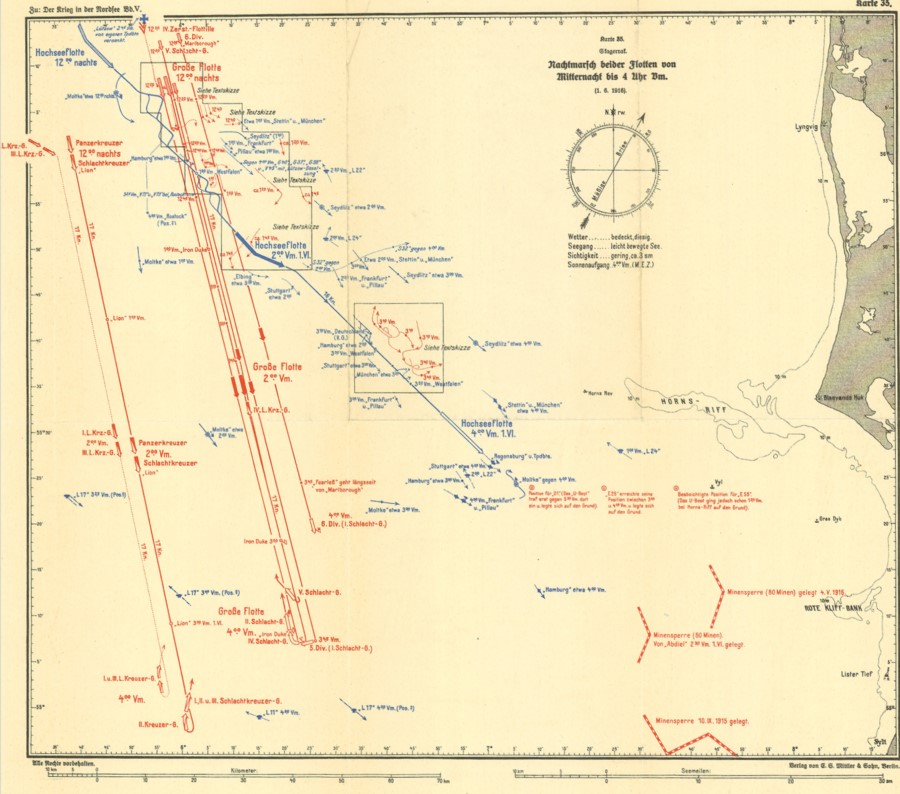
At around 0200, after a brief lull, the British destroyers again clashed with the German fleet. They were running low on torpedoes, and several were damaged. One, Turbulent, was sunk when rammed by Rheinland. Again, no report was made to Jellicoe.
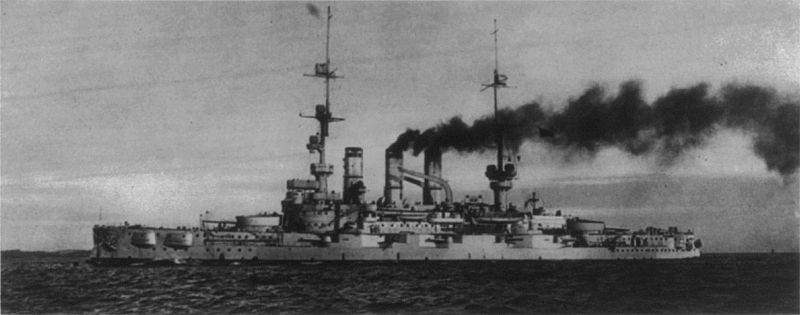
SMS Pommern
The British finally managed to score a serious blow at 0307, when the 12th Destroyer Flotilla launched a torpedo attack which hit the pre-dreadnought Pommern. Pommern shared the fate of Black Prince, lost with all hands. By this point, Scheer was well to the east of Jellicoe, and only 16 miles from the entrance to Horns Reef and safety. A last, indecisive, clash half an hour later brought the battle to a close.
The survival of Moltke and Seydlitz was particularly surprising. Moltke passed right by Thunderer, and survived only due to her captain’s insistence on not giving away the battle fleet. Seydlitz apparently passed three British dreadnoughts, and even exchanged recognition signals with them. Marlborough’s gunnery officer later regretted not disregarding orders to hold his fire. Seydlitz nearly ran aground on Horns Reef but managed to avoid taking any more damage.
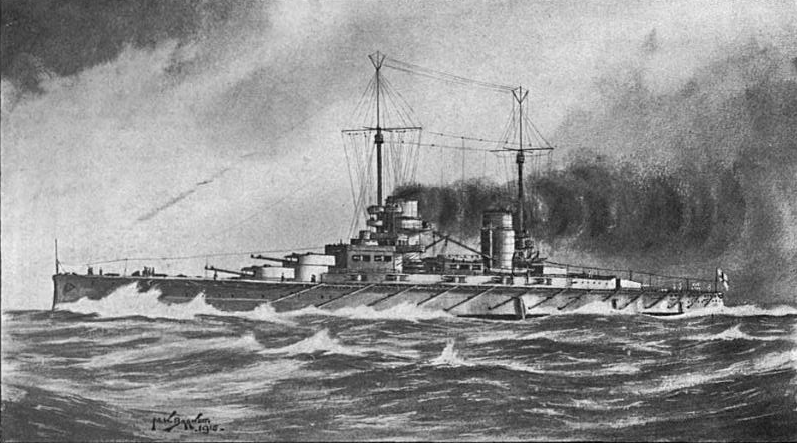
SMS Lutzow
Lutzow was not so lucky. At around 0300, it became obvious that she was not going to survive, and most of her crew was taken off by destroyers. Some were unable to evacuate, and a total of 597 men went down with her.
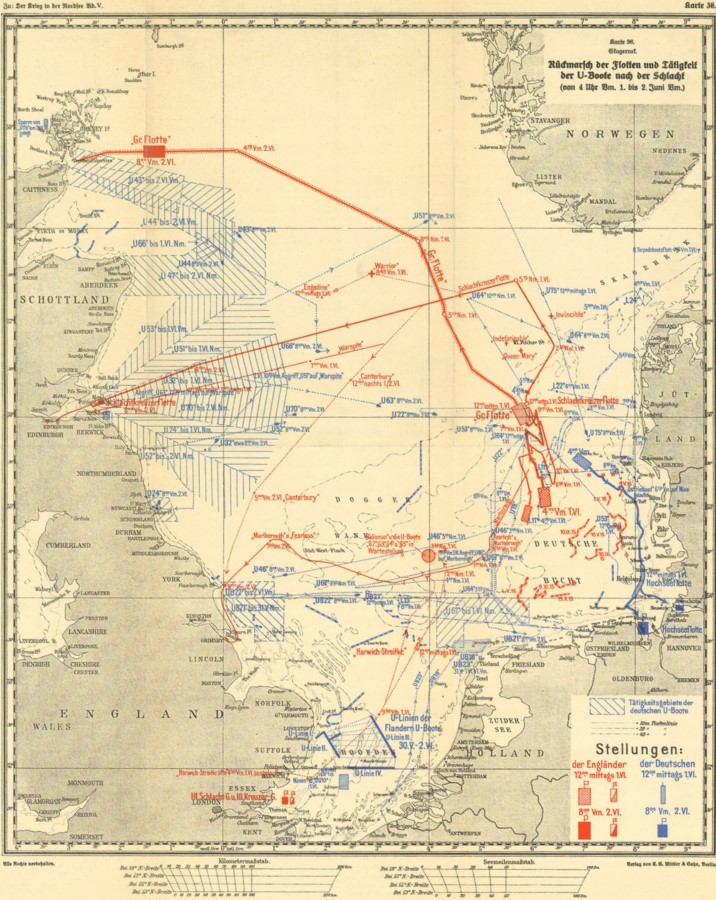
At 0330, Jellicoe ordered the Grand Fleet back to the north, and reformed it into daylight formation at 0513. Two minutes later, he learned that the Germans had in fact reached safety. He didn’t learn of the loss of Indefatigable and Queen Mary until 1100, a final example of Beatty’s tardiness in reporting, and it took another round of signals to learn the circumstances of their loss. After a few hours of searching for survivors (or any remaining German ships), the British turned for home.
The greatest clash of dreadnoughts was over, but the controversy it sparked would rage on for decades, with some issues undecided even today, over a century later. That will be our subject for next time.

Comments
I've heard a vague mention of this before. Is it a subject you can expand upon?
The late Victorian RN has a reputation for being rather complacent and more concerned with paintwork and polish than combat effectiveness. There's some truth to it, although the extent is often overstated. Unfortunately, I can't give a full summary offhand. I haven't read a whole lot on that era lately, which means the evidence has been pushed out by other stuff. Jackie Fisher was a leading advocate of being ready to fight on a moment's notice, and he got policies changed quite effectively when he was in charge, but before him, a typical firing schedule was a couple rounds twice a year, at a stationary target at short range.
That would be related to the fact that the British navy didn't face any actual foes between 1815 and 1914 wouldn't it?
That's not quite true, despite what the traditional account would have you believe. There was a fairly serious naval component in the Baltic during the Crimean War, although it's barely remembered today. The RN also participated in all of the various colonial wars, although usually not with battleships. Those did see action once, and I've discussed that here. There was a very real threat from France and Russia throughout. While it never materialized, it shouldn't be written off as a driver of British thinking.
I've added a new paragraph about some justifications for the British performance after checking Fighting the Great War at Sea. It's the second one below the first map.
I just read Castles of Steel, and came away with the impression that the naval component of WWI (at least the RN parts of it) was just So Very WWI.
The battles are won or lost by, essentially, luck, in the end, and that (as beaten to death by basically everyone) the RN basically, by Not Losing, and by managing to stumble into (or be dragged into, in some cases, notably convoying ships) coherent and effective strategies.
I think that's unfair to the RN. There was a tremendous amount of thought that went into what they were doing, and most of their errors (with the exception of convoying, which was apparently discarded based on an old study showing it to be ineffective against surface raiders) were just because of how fast things were changing. To put that into perspective, consider this: USS Enterprise (CVN-65) was commissioned in 1961, almost exactly a century after HMS Warrior. She decommissioned in 2012. In 1912, a ship from 1861 would have been laughably obsolete, and pretty much the entire active fleet was 10 years old or less. And there would be major tactical shifts (most notably in the employment of destroyers) in the two years between 1912 and the outbreak of war.
"Not Losing" didn't happen by accident: one of my big takeaways from Massie's books (Dreadnought and Castles) was that the heart of Fisher's grand strategic plan for a war with Germany was Not Losing at sea was far more important than Winning. Germany, as a continental power, could be weakened by blockade but could only be defeated decisively on land, whereas losing control of the seas would be absolutely disastrous for Britain. Churchill wholeheartedly agreed with this principle, and Jellicoe had been hand-picked by Fisher and Churchill to command the Grand Fleet because they felt him the best man to implement that strategy.
The Royal Navy's big flaws in WW1 mainly seem to come down to three big things: 1. The rapid pace of technological advance Bean discussed, combined with the very long period without significant peer-level naval wars between Great Powers. As far as I can remember off the top of my head, all major Great Power naval campaigns between the Congress of Vienna (1815) and the July Crisis (1914), except maybe the Russo-Japanese War, were one-sided curbstomps (Britain and France vs Russia in the Crimean War), only marginally and debatably qualified as Great Powers (the American Civil War), or both (the Spanish-American War). Figuring out new doctrines and tactics in response to major technological shifts is hard, takes time, and is fundamentally based on guesswork unless and until you get real combat experience. 2. Communications technology (particularly long-range two-way radio) had made a radically new level of strategic micromanagement possible, and Churchill frequently succumbed to the temptation. And the technology was still new enough that it's hard to say Churchill should have known better. 3. David Beatty was breathtakingly incompetent as a senior Admiral. An entire top-level post could be written on the subject, and I believe Bean has called out most of Beatty's major missteps in the Jutland series and other related posts.
Well said, Eric. The only thing I'd add is that 2 was much more an issue with Churchill than the technology. While the tech played a part, and lesser men have succumbed to the same temptation (ordering USS Constellation to orbit at 30,000' springs to mind) from a military perspective, he was an incorrigible meddler and dreamer of grand peripheral operations which never made as much sense as he thought. During WWII, the military had wised up, and had Booke to sit on him and keep him from pulling another Gallipoli, but in WWI, nobody seems to have been on that job, particularly after Fisher resigned.
I really should write more on the RN in WWI, but I have so many other topics to cover...
I was being overly harsh in my language. When I said "stumbled into effective doctrine" it was still better than anyone else managed, and they were exploring the problem space in a way that the Germans were not doing.
I've read both Dreadnaughts and Castles, and also came away with the impression that "Not Losing" was a deliberate and well-thought-out plan, not at all accidental, on Fischer's part. (And that Beatty was a stellar example of the Peter Principle, on his best days.)
In the end, it all worked, and while "winning a battle" was a matter of luck, Not Losing was a matter of calculation and planning.
In this case, I think it's a matter of how we define winning. If we look at the top-line score, things like casualties and tonnage sunk, it's clearly the Germans. If we look at achieving their strategic effect, then it was clearly the British.
At the very best, the Germans won the battle and lost the war. And I think that's being too generous to the Germans. Even their immediate goal was to inflict irreplaceable and unbalanced losses on the RN, and they failed at that.
Their long-term goal was to prevent the Grand Fleet from being able to defend the blockade, and that was miserable failure. Regardless of the "score," they failed to change matters. The had to "win" to win. RN had to "not lose" to win. QED (even if it is a bit of a tautology.)
SEYMOUR!!! No, really, how did that happen? Somebody burned/jettisoned/etc. them because they panicked and thought the books would fall into German hands ...why did they think that, exactly? Or if not that, then what happened; how can you lose the codebooks of a ship?
The room where they're stored gets hit by a shell. I'm not 100% sure that's what happened, but it seems by far the most likely case, given how much damage Lion took.
A succesful Gallipoli would have taken Turkey out of the war and opened up the Black Sea. Knowing what we know now, Russia might have lasted at least another year. Also, it would almost certainly have kept Bulgaria neutral and helped the Romanians against Austria and created extra fires for the Germans to have to put out. Worth a few divisions of infantry and some old battleships.
The naval attack at Gallipoli made a lot of sense. After it failed, the British as a whole systematically underestimated the difficulties of the land attack. And that comment was directed as much at Churchill's later record during WWII, when Alan Brooke's job was basically to sit on him and stop him from squandering troops on every silly idea that popped into his head. The balance between his theories on death by a thousand cuts and the American obsession with going the most direct way actually worked pretty well.
True that. I think Churchill's strategy was mostly constrained by his perception of what could be done. The US simply had logistics orders of magnitude beyond his.
I agree, but I’d phrase it less charitably: Churchill could never resist the fantasy of achieving major results with secondary forces. And in WWII his horror of suffering Western Front losses again made him seize on any idea for fighting the German army where the German army wasn’t. (A rhetorical exaggeration, but basically true.)
Correlli Barnett’s old (1970) history of the British Army places Churchill’s strategic blunders in useful context. Going right back to Elizabeth’s war with Spain, Britain tended to waste the early years of any war on the delusion that sea power and modest expeditionary forces could bring victory cheaply, before facing the unpleasant fact that defeating a great Continental enemy would require a large British army on the Continent.
Let me revise my earlier statement. A well-planned and appropriately-resourced attack on Gallipoli could have been very useful. That is not what happened, and I don't think the plan as actually carried forward had much chance of working. But I need to dig deeper in Gallipoli, which has been holding up Coastal Defenses Part 7 for months now.
And I'd disagree that the British always (or usually) needed a Continental Army to achieve results. It was always at its best as paymaster and naval support in an alliance. That did usually involve putting troops in the field, and I'd almost expect an Army-centric history to emphasize those, but in the wars of the 18th century, fighting in the colonies usually worked quite well. Things started to go wrong in the 19th century, with the Crimean War as the prime example. I'm still not sure what a good strategy in 1914 would have looked like.
In my mind a 1914 strategy has to revolve around the blockade, and a two front war. Britain had to keep France in the war, and, if possible, keeping Russia in the war would also have been greatly beneficial. That probably means a substantial army. The blockade went pretty much to plan, but if the war on the continent had ended early enough, it wouldn't have done the job.
For Germany, it's the reverse - knock out one opponent ASAP (though in retrospect Russia might have been a better choice than France) and keep the US sympathetic and opposed to the blockade. If you do go for Russia first, it'd probably be best to avoid Belgium. That leaves France more powerful, but less angry, and shortens the front you have to hold. With victory in the east, talk up your desire for peace, and Polish national self determination, and try and get Wilson to meddle in your favour. I imagine that the entente won't be too eager to keep storming the trenches indefinitely.
Knocking out Russia has been the desire of a liot of would-be world conquerors over the years. And it has ruined a bunch of those plans. And nobody expected the grinding trench warfare of the Western Front. (And in the end, of course, they did KO Russia.
Germany can only win if the US does not enter the war, or at least can't get forces to the Western Front before the end of the war.
Given the conditions Germany was facing, the plan they came up with was actually not too terrible. Russia is really big, which makes knocking it out militarily a very hard task, and something you should not attempt quickly. France is much smaller, and there's a chance you'll be able to pull it off. The problem was that they confused the best possible plan for a bad situation, which they should hope they never have to use, with an actually good plan that they should use. This is a common failing of military-dominated governments, and much the same thing happened to Japan in 1941.
Appealing to Wilson, particularly by invoking Polish nationalism, would have required a completely different mindset on the part of the German government. And if they had been able to think that way, then I don't think they would have pushed the world into war.
Yeah, the relative distance from the German border to Paris and Moscow made France look like the easier target. I don't think the Russian collapse was easy to forsee.
My suggested plan for Germany was to fight as small a war as possible, and avoid escalation to make a negotiated settlement as easy and painless as possible. Not starting the war would be entirely in line with that, but is a bit of a dodge if the question is 'how can they win the war'. I suppose since the actual question was what Britain's strategy should have been, I'd already veered well off track.
...in the wars of the 18th century, fighting in the colonies usually worked out quite well. (Bean)
I’m sorry you put in that “usually”, denying me a glib retort about the American war. More seriously, it depends on the construction you place on “worked out quite well”. Certainly the British could exploit their naval superiority to seize control of some of the enemy’s colonies by the end of a war, and those colonies were then useful as bargaining chips in the eventual peace negotiations, or as permanent acquisitions. But colonial campaigns in which only small or local forces were lost, involving no threat at all to the homeland, couldn’t by themselves place sufficient pressure on the Spanish or French to make peace.
In any case, Barnett reserves his greatest scorn not for British colonial operations, but for amphibious strikes against the enemy’s European periphery, of which Gallipoli was the great late example. Almost every serious British war from Drake to Wellington involved futile, expensive, sometimes disastrous operations of this kind: Portugal (1589), the Île de Ré (1627), Cherbourg and Saint-Malo (1758), Walcheren (1809), et cetera ad nauseum. The idea of landing a small army at a lightly defended point, rather than grasping the nettle and fielding a large one, failed consistently for centuries. Contemporary critics called the amphibious strategy “breaking windows with guineas”.
As a side note, this kind of strategy was often combined with delusional optimism about the political multiplier effects the landings could achieve. The Île de Ré operation was supposed to revive the Huguenot cause against the French government, and the landings in ostensibly Royalist western France in the Revolutionary/Napoleonic era had a similar goal. Perhaps there’s a parallel with the unhappy experiences of the Anglophone nations in waging half-political wars from Vietnam onward.
My thoughts on this are largely drawn from reading Friedman's Seapower as Strategy, which was rather more positive towards the concept, a couple years ago. I'll admit that it didn't always work, but I got the impression that it was generally pretty successful. If nothing else, the big army was less big than most of the other European armies, and it was never vital to Britain's survival, which was a nice place to be.
Certainly even large armies, by British standards, never came close to supplying half the manpower of the successful coalitions, though they usually provided the most reliable troops. But they were also valuable as a demonstration that the British had skin in the game—-that they weren’t just perfide Albion waging war with their gold and other nations’ blood. Historians typically use the “glue of the coalition” metaphor.
I think our differences here boil down to seeing British military history from an Army as opposed to a Navy perspective, as you’ve suggested.
Re-reading some passages in Barnett, I was reminded that when Britain campaigned in Spain during the War of the Spanish Succession (1701-1714), infantry regiments could lose 300 of 800 men on the voyage to Iberia. By Wellington’s time, this wasn’t a major problem. I know that period isn’t your main concern, but it would be interesting to know what changes the Royal Navy made to improve so much in keeping soldiers alive.
I don't remember anything on that specifically, but the later half of the 18th century saw significant improvements in the logistics of the British war effort. The Royal dockyards were the largest industrial employers in the country, and the other areas (victualling board, Transport Board, etc) were generally models of efficiency for the time.